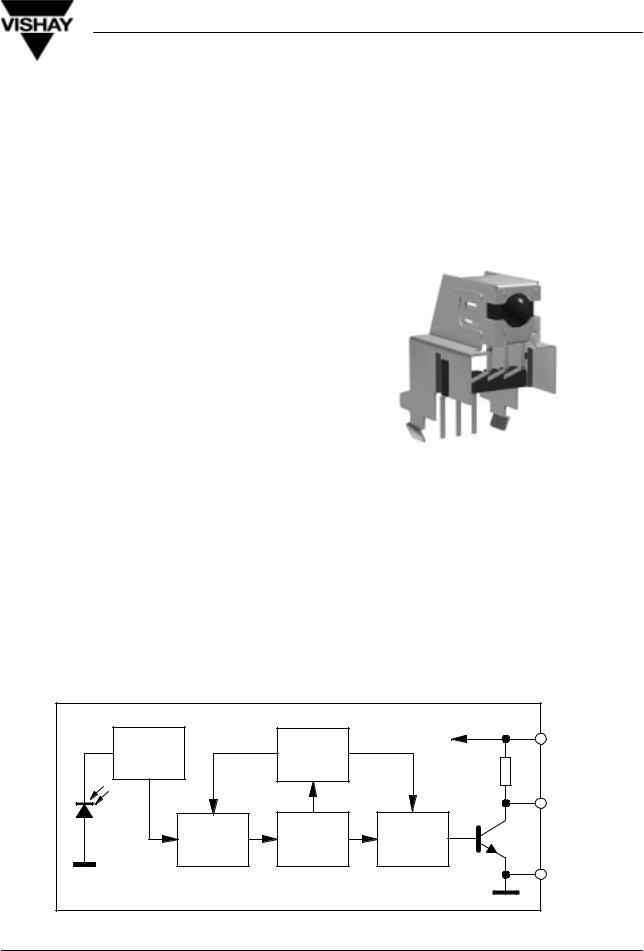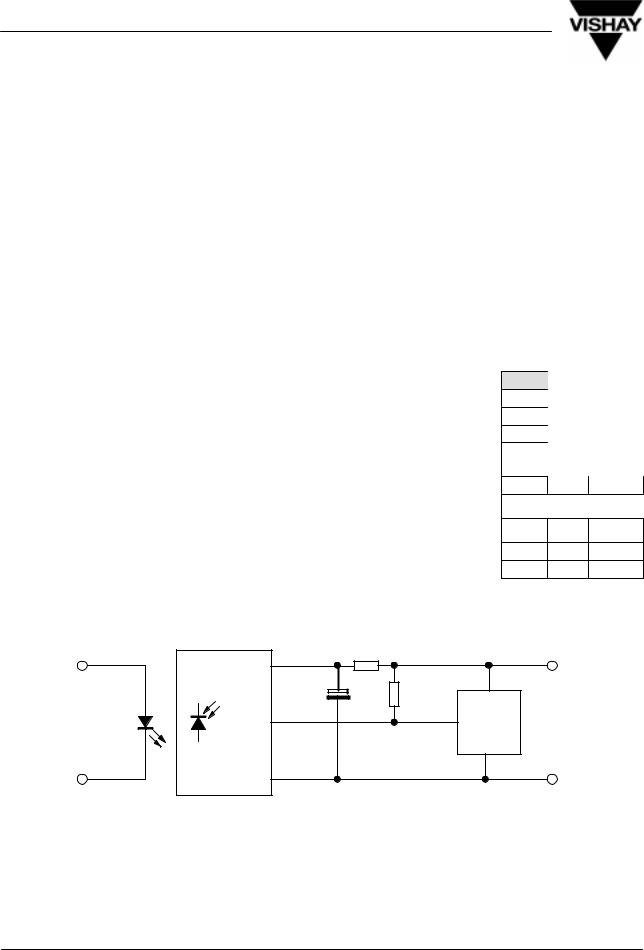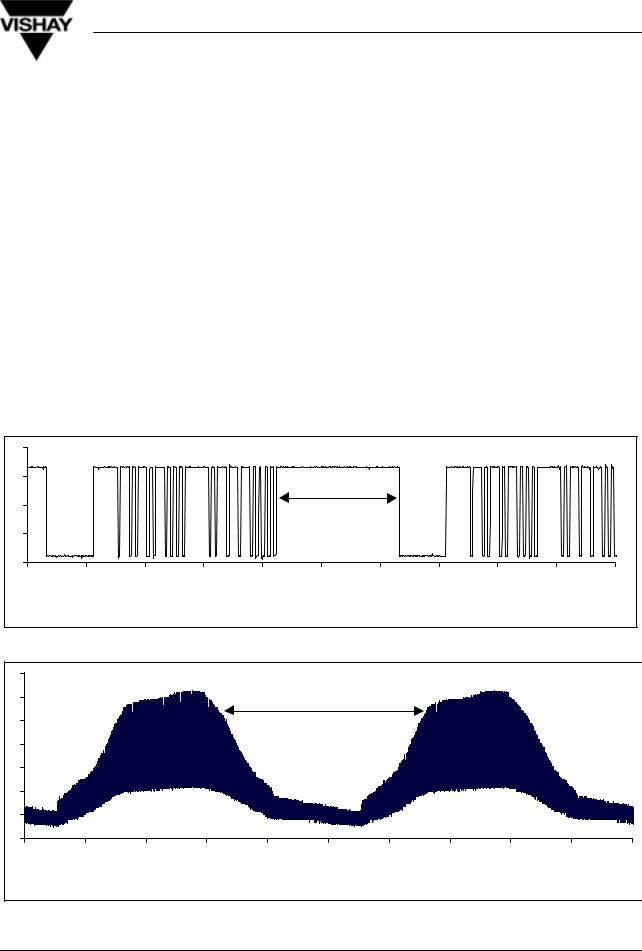Telefunken TSOP1856PM1, TSOP1836PM1, TSOP1838PM1, TSOP1837PM1, TSOP1833PM1 Datasheet
...
TSOP18..PM1
Vishay Telefunken
Photo Modules for PCM Remote Control Systems
Available types for different carrier frequencies
Type |
fo |
Type |
fo |
TSOP1830PM1 |
30 kHz |
TSOP1833PM1 |
33 kHz |
TSOP1836PM1 |
36 kHz |
TSOP1837PM1 |
36.7 kHz |
TSOP1838PM1 |
38 kHz |
TSOP1840PM1 |
40 kHz |
|
|
|
|
TSOP1856PM1 |
56 kHz |
|
|
Description
The TSOP18..PM1 ± series are miniaturized receivers for infrared remote control systems. PIN diode and preamplifier are assembled on lead frame, the epoxy package is designed as IR filter.
The demodulated output signal can directly be decoded by a microprocessor. The main benefit is the reliable function even in disturbed ambient and the protection against uncontrolled output pulses.
16115
Features
Photo detector and preamplifier in one package
Internal filter for PCM frequency
TTL and CMOS compatibility
Output active low
Improved shielding against electrical field disturbance
Suitable burst length ≥ 6 cycles/burst
Special Features
Small size package
Enhanced immunity against all kinds of disturbance light
No occurrence of disturbance pulses at the output
Short settling time after power on (<200 s)
Block Diagram
|
|
|
3 |
Input |
|
Control |
VS |
|
|
||
|
Circuit |
|
|
|
|
30 k |
|
|
|
|
|
|
|
|
1 |
PIN |
|
|
OUT |
|
|
|
|
|
AGC |
Band |
Demodu- |
|
Pass |
lator |
|
|
|
||
|
|
|
2 |
|
|
|
GND |
|
|
|
9612226 |
DocumentNumber 82048 |
www.vishay.com |
Rev. 3, 10-Oct-00 |
1 (7) |

TSOP18..PM1
Vishay Telefunken
Absolute Maximum Ratings
Tamb = 25_C |
|
|
|
|
Parameter |
Test Conditions |
Symbol |
Value |
Unit |
Supply Voltage |
(Pin 3) |
VS |
±0.3...6.0 |
V |
Supply Current |
(Pin 3) |
IS |
5 |
mA |
Output Voltage |
(Pin 1) |
VO |
±0.3...6.0 |
V |
Output Current |
(Pin 1) |
IO |
5 |
mA |
Junction Temperature |
|
Tj |
100 |
C |
Storage Temperature Range |
|
Tstg |
±25...+85 |
C |
Operating Temperature Range |
|
Tamb |
±25...+85 |
C |
Power Consumption |
(Tamb 85 C) |
Ptot |
50 |
mW |
Soldering Temperature |
t 10 s, 1 mm from case |
Tsd |
260 |
C |
Basic Characteristics
Tamb = 25_C |
|
|
|
Parameter |
Test Conditions |
Symbol |
Min |
Supply Current (Pin 3) |
VS = 5 V, Ev = 0 |
ISD |
0.9 |
|
VS = 5 V, Ev = 40 klx, sunlight |
ISH |
|
Supply Voltage (Pin 3) |
|
VS |
4.5 |
Transmission Distance |
Ev = 0, test signal see fig.6, |
d |
|
|
IR diode TSAL6200, IF = 300 mA |
|
|
Output Voltage Low (Pin 1) |
IOSL = 0.5 mA,Ee = 0.7 mW/m2, f = fo |
VOSL |
|
Irradiance (30 ± 40 kHz) |
Pulse width tolerance: |
Ee min |
|
|
tpi ± 4/fo < tpo < tpi + 6/fo, |
|
|
Irradiance (56 kHz) |
Ee min |
|
|
test signal (see fig.6) |
|
||
Irradiance |
|
Ee max |
30 |
Directivity |
Angle of half transmission distance |
ϕ1/2 |
|
Typ |
Max |
Unit |
1.2 |
1.5 |
mA |
1.2 |
|
mA |
|
5.5 |
V |
35 |
|
m |
|
|
|
|
250 |
mV |
0.3 0.5
0.5  mW/m2
mW/m2 
0.4 0.7 mW/m2
W/m2
±45 deg
Application Circuit
|
|
100 *) |
+5V **) |
|
3 |
F *) |
|
|
4.7 |
>10 k |
|
|
TSOP18..PM1 |
|
|
TSAL62.. |
|
|
optional |
1 |
|
C |
|
|
|
||
|
|
|
|
|
2 |
|
GND |
|
|
|
|
15905 |
*) recommended to suppress power supply disturbances |
||
|
|||
www.vishay.com |
DocumentNumber 82048 |
2 (7) |
Rev. 3, 10-Oct-00 |

TSOP18..PM1
Vishay Telefunken
Suitable Data Format
The circuit of the TSOP18..PM1 is designed in that way that unexpected output pulses due to noise or disturbance signals are avoided. A bandpassfilter, an integrator stage and an automatic gain control are used to suppress such disturbances.
The distinguishing mark between data signal ( not suppressed) and disturbance signal (supressed) are carrier frequency, burst length and Signal Gap Time (see diagram below).
The data signal should fullfill the following condition:
•Carrier frequency should be close to center frequency of the bandpass (e.g. 38kHz).
•Burst length should be 6 cycles/burst or longer.
•After each burst a gap time of at least 9 cycles is neccessary.
•The data format should not make a continuous signal transmission. There must be a Signal Gap Time (longer than 14ms) at least each 90ms
Some examples for suitable data format are:
NEC Code (repetitive pulse), NEC Code (repetitive data), Toshiba Micom Format, Sharp Code, RC5 Code, RECS±80 Code, R±2000 Code.
When a disturbance signal is applied to the TSOP18..PM1 it can still receive the data signal. However the sensitivity is reduced to that level that no unexpected pulses will occure.
Some examples for such disturbance signals which are suppressed by the TSOP18..PM1 are:
•DC light (e.g. from tungsten bulb or sunlight),
•Continuous signal at 38kHz or at any other frequency,
•Signals from fluorescent lamps.
•Continuous IR signal (e.g. 1ms burst, 2ms pause)
|
|
|
|
|
Signal Gap Time |
|
|
|
|
|
0 |
10 |
20 |
30 |
40 |
50 |
60 |
70 |
80 |
90 |
100 |
|
|
|
|
|
time [ms] |
|
|
|
|
|
Figure A: Data Signal (Output of IR Receiver) with a Signal Gap Time of 20ms
|
|
|
|
Signal Gap Time |
|
|
|
|
|
|
0 |
2 |
4 |
6 |
8 |
10 |
12 |
14 |
16 |
18 |
20 |
|
|
|
|
|
time [ms] |
|
|
|
|
|
Figure B: Disturbance Signal from Fluorescent Lamp with Signal Gap Time of 7ms
DocumentNumber 82048 |
www.vishay.com |
Rev. 3, 10-Oct-00 |
3 (7) |
